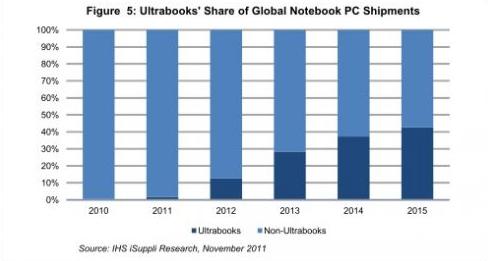 According to a research report of the computing platform division of IHS iSuppli Corporation, in order to withstand the increasing threat of media tablets, the mobile PC market is pushing for a new super platform, and its shipment volume is expected to account for more than 40% of the overall notebook market by 2015.
According to a research report of the computing platform division of IHS iSuppli Corporation, in order to withstand the increasing threat of media tablets, the mobile PC market is pushing for a new super platform, and its shipment volume is expected to account for more than 40% of the overall notebook market by 2015. In 2015, Superbooks will account for 43% of Global notebook shipments, compared with 2% and 13% in 2011 and 2012, respectively, as shown in Figure 5. Following the first shipment in 2011, the share of Superbooks in the notebook market will rise rapidly, rising to 28% in 2013 and rising to 38% in 2014.
In order to compete with media tablets, notebook PCs must become more engaging and enhance consumer appeal. The media tablet has reversed the momentum of the previous rapid expansion of the Internet platform, PC manufacturers are now deeply aware that the notebook must continue to evolve in order to maintain market growth and an important position. The Ultrabook borrowed some of the advantages of the media tablet's form factor and user interface to enhance its appeal.
Although the media tablet is not expected to end the notebook market, it is causing its growth to slow down.
Driven by the Apple iPad, the media tablet market will thrive in the coming years, and the combined annual growth rate (CAGR) of global shipments in 2011-2015 will be higher than 42%. While the notebook market has entered a mature stage, the CAGR for the same period will be only 10%.
Superbook debut is defined in the industry as a very thin and light notebook with a thickness of less than 0.8 inches. Although the Ultrabook uses a complete PC operating system such as Microsoft Windows, it also adds some common features on media tablets, such as activating and maintaining wireless connections at any time. Solid state drives and one charge can last more than 8 hours. The price target for the Ultrabook is less than $1,000, but most of the early products are expensive.
It is expected that the future ultrabook will adopt a convertible form and touch screen, and users can use it as a notebook or a tablet computer as needed.
The initial target market for the ultrabook will be the consumer market. However, PC manufacturers may also develop models for enterprise users.
There are a number of vendors promoting Intel’s Ultrabook. The strongest supporter is Intel, the microprocessor giant. Intel put forward the concept of superbook at the 2011 International Computer Show in Taipei and discussed the concept at the Intel Developer Forum (IDF) in September.
Intel’s vision for Ultrabook includes adopting the company’s second-generation Core microprocessors with Microsoft’s upcoming Windows 8 operating system. Intel said that the first Intel-based ultrabooks are expected to be launched before the Christmas sales season this year, and PC OEMs such as Acer and Asustek have already sold Ultrabooks.
Intel also previewed the next generation of ultrabooks to be launched in 2012 at IDF. These products will use third-generation Core microprocessors codenamed Ivy Bridge.
The inflection point Although Intel's move to promote Superbook is considered to be a response to the rise of the media tablet, it also paved the way for revitalizing this electronic product supply chain.
With the introduction of the ultrabook, the computing industry will usher in yet another paradigm shift. The prior art can bring about the integration of major mobile devices. If the attractive price can be achieved and consumers feel that this is an essential product, the entire semiconductor production supply chain may quickly turn to support the rapidly growing ultrabook market. This development may stop the downturn in the semiconductor and electronics manufacturing industries.
In the ultrabook era, technology needs will not be limited to a few companies. Ultrabooks require a variety of materials, so companies that focus on storage, logic circuits, and power management will all benefit.
One potentially high-growth area will be flash memory. Moving from the hard disk drive used in laptops to the ultra-solid state drive will boost the demand for flash memory units while keeping the average price stable. These advantages will not only be for chip manufacturers but will also have a positive impact on other players in the supply chain, such as battery suppliers and electronics contract manufacturers.
The author, Matthew Wilkins, is the Chief Analyst for Computing Systems at IHS. Len Jelinek is director of semiconductor manufacturing research and analyst at IHS.
Led Light Led Panel Co., Ltd. , http://www.yl-led.cn